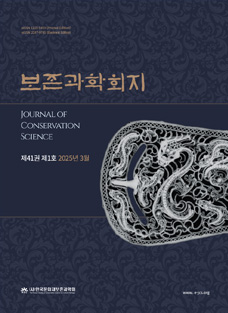Journal of Conservation Science Vol.31 No.3 pp.255-265
한국 포타쉬 유리구슬의 조성 분류에 따른 특성 비교
Characteristic Comparison of the Composition Classification on Potash Glass Beads Excavated in Korea
Abstract
In this study, the potash glass beads of 281 samples in 30 sites analyzed until now were classified according to the chemical composition. And the color, size, manufacturing technique and distribution period were compared. Korea potash glass beads are divided into 3 types depending on the stabilizer content. Ⅰ, Ⅱ type is the CaO and Al2O3 content of less than 5%. Relatively, Ⅰ type has a high CaO and Ⅱ type has a high Al2O3. In contrast, Ⅲ type comprises more than CaO 5%. Ⅰ, Ⅱ type is the saltpetre, Ⅲ type is estimated using plant ash as row material of flux. A review of the properties by type, Ⅰ type is cobalt blue, copper blue and purple beads. The outer diameter is sized to the range 1.4 ~ 7.4㎜. Also it was produced by the drawing technique. It was used continuously from BC 1C until around AD 6C. On the other hand, Ⅱ type is outer diameter of 1.9 ~ 3.6㎜ and a copper blue beads. manufacturing technique is the same as the Ⅰ type. This seems to have been in use since around AD 1C to 4C. Finally, Ⅲ type is brown, colorless, amber beads and an outer diameter of about 10㎜. It was formed by winding technique and appeared in the tombs of Goryeo and Joseon Dynasty. As a result, 3 types of potash glass beads distributed in Korea is likely to flowing through the various trade routes from different provenances.

 E-Submission
E-Submission 
 E-Submission
E-Submission 
![]() Journal Search Engine
Journal Search Engine




 KSC
KSC